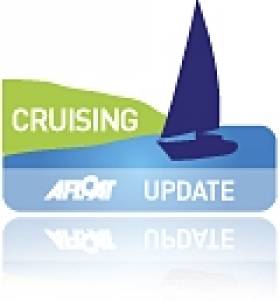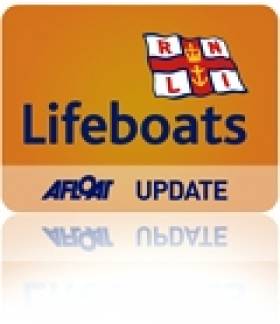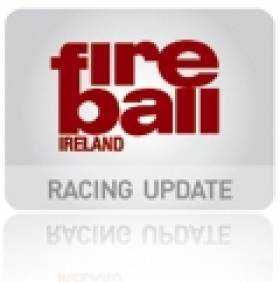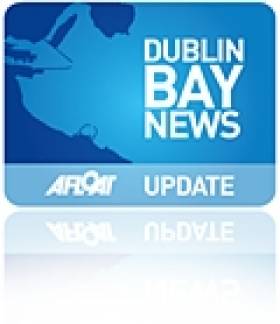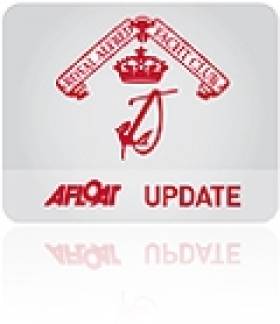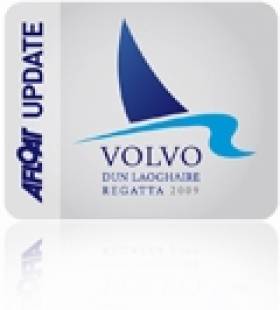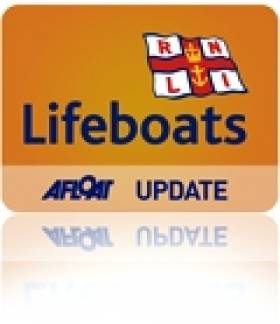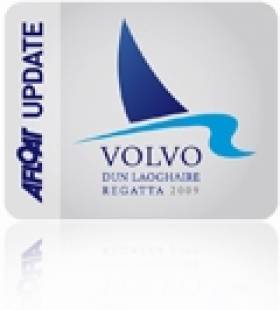Displaying items by tag: Dun Laoghaire
Cruising Association Holds First 2011 Meeting on Dublin Bay
Dinner will be served at 8pm at a reduced cost of only €20 per person, Drinks in the bar, wine available @ €18 per bottle.
The is rally open to all cruising sailors, and there will be a brief presentation of the Strangford Lough cruise in late July.
The Cruising Association AGM will be held in a private room from 1900 – 1930 for CAI members interested in attending.
Latest Cruising news
17 Boats to Contest First ISORA Offshore of the Season
There are 17 definite entries and it is estimated up to another half a dozen could be sailing to the line next Saturday morning for the first race of the 2011 ISORA series.
The impressive early entry follows a series of offshore sailing talks held at the National Yacht Club earlier this month.
Click this link for the latest ISORA news.
The 57-mile course across the Irish Sea from Dun Laoghaire on the Irish east coast to Holyhead in Wales will be decided on the morning of the race at the National Yacht Club and transmitted by VHF on 37 for the first offshore race of 2011.
Last year's overall champion, Raging Bull, a Sigma 400, from Skerries and skippered by Matt Davies is slated as a possible contender.
ISORA Chief Peter Ryan has issued sailing Instructions as follows:
2011 Sailing Instructions
Supplementary Information
Race 1 Dun Laoghaire - Holyhead
Sailed under the burgee the National Yacht Club
Saturday 30th April 2010
TIME OF START FOR ALL CLASSES
07.55 Warning signal - Class flags (Numerals 1 & 2) hoisted
07.56 Preparatory Signal - Blue Peter hoisted
07.59 Blue Peter down
08.00 Start – Class flags down
The start may be broadcast on VHF Channel 37 (M1)
STARTING LINE
The start line shall be located in Scotsman's Bay between the DBSC 'Pier' mark and an adjacent committee boat that may be using engine power to hold station. This changes RRS 62.1(a).
THE COURSE (57 miles approx)
1. STARTING LINE
2. KISH Lighthouse (S)
3. M2 Buoy (S) 53 28.8N 5 25.5W
4. FINISH LINE
FINISH LINE
The finish line shall be between the end of the Holyhead breakwater and the Clippera Buoy – 0.6
miles off pier head, bearing 067(T).
Boats approaching the finish should contact "ISORA Finisher" on VHF Channel 37 (M1) when 1 hour
from the finish and again at 10 minutes from the finish. Please note that the finisher will only have a
handheld radio and you may not receive an acknowledgment to the first contact.
The finish time and the time due North of M2 should be recorded in the log by each boat and text to
ISORA at 00353 87 2545037 as soon as possible after the race as a Declaration.
RETIREMENTS
Telephone National Yacht Club 00353 1 2805725 and text ISORA 00353 87 2545037
For safety it is recommended to also inform the coastguard
NOTES
1. Keep a close lookout for commercial traffic when entering or exiting Dun Laoghaire and
Holyhead. The Stena HSS in particular can be hard to spot from behind the breakwater.
2. The time of crossing the finish line should be noted in the log.
3. Dinner will be available at Holyhead Sailing Club on Saturday evening. Phone No. 0044 1407
762526
4. Berthing in Holyhead Marina can be arranged. Phone 0044 1407 764242
Dun Laoghaire Lifeboat Rescues Four as Speedboat Hits Rocks
Four people were rescued by the Dun Laoghaire RNLI lifeboat earlier today when their small powerboat hit rocks off Killiney Beach in south county Dublin. Nobody was injured in the incident that occurred shortly after 11am while the two men and two women were enjoying a pleasure outing.
The 22-foot open powerboat hit the submerged rocks two hours after low-tide and the collision caused damage to the engine. The crew contacted the Irish Coastguard who alerted the RNLI at Dun Laoghaire and the all-weather lifeboat (ALB) launched within ten minutes.
The casualty vessel dropped anchor close to the rocks to avoid being driven onto the beach by the fresh breeze and flood tide. On arrival, the ALB launched its daughter boat with two crew that passed a tow-line to the casualty that was then brought to Dun Laoghaire.
"Before taking a boat-trip, its important to check for local knowledge that will help avoid significant hazards," commented Stephen Wynne, Lifeboat Operations Manager at Dun Laoghaire. "The four people rescued were all wearing life-jackets and followed the correct procedure in calling for assistance."
At the end of every season there is always speculation about who will be buying new boats and what new combinations will be sailing together the following season. The advent of a World Championships heightens that speculation and with the Fireball Worlds scheduled for June 2011 in Sligo, the Irish fleet were the beneficiaries of this fevered activity writes Cormac Bradley.
At the close of the 2010 season the word was that there would be at least one new boat coming into Ireland for 2011. Ironically, the speculation about these individuals' plans has not been resolved because they are not partcipants in the Dun Laoghaire Frostbite Series, coming as they do from the northern side of the Liffey.
Then the word was out of first one and then two new boats, both coming to Dun Laoghaire. Both have now arrived to Stephen Oram and Kenny Rumball respectively. Kenny's boat is still in dry storage (as advised as recently as last Sunday, 1oth April), but Stephen's boat has already taken to the water. Both boats will have numbers around the 15060 mark, as I have seen a photo of 15057 at the Dinghy Exhibition in London in March.
Both boats will be sailed by new combinations. Stephen Oram teamed up with Noel Butler for the Frostbite Series which they won, despite significant on the water competition from Rumball and others. However, it seems the partnership will extend into the 2011 summer season and the Worlds in June. Seamus Moore announced his (premature) retirement from Fireballs after the Barbados Worlds to go running on a serious basis and among his achievements was completing the New York marathon. However, by the time of the 2010 Fireball Nationals, in Baltimore, he was teamed up with Kenny Rumball to finish 2nd overall and they saw out the season in Dunmore East and the Munsters Championships, which they won.
In addition to being very competitive in the Frostbites, the pair were going afloat early on Sunday mornings to get more time on the water. Thus it would appear that they are an "item" for the Sligo Worlds.
Therefore, as the eve of the 2011 regatta season approaches, these two are at the leading edge of the domestic fleet. There are other more established partnerships that will also contest Sligo, Owen Laverty & Ed Butler (Snr), Frank Miller & Grattan Donnelly, Andy Boyle & Brian Flahive among others but none of these have been able to consistently knock Butler/Oram or Rumball/Moore off the winning path.
Over the winter, the most successful Irish Fireballer internationally, outside the aforementioned, in recent times, Francis Rowan, has been conspicuous by his absence. Francis, sailing with red-hot talent from the UK, Tom Gillard (2010 European Champion), was placed third at the 2009 Fireball Europeans in La Rochelle, winning one race, and was placed inside the top ten at the Worlds the following week, again winning a race. To date there isn't a whisper of Francis' 2011 plans.
The domestic season kicked off last weekend, 9/10th April, with Silver Fleet training in Killaloe, organised by Neil Colin. This weekend coming (15/16th April) we have another training weekend with Adam Bowers at the Royal St. George Yacht Club in Dun Laoghaire. Adam is the perennial coach to the British Cadet Class and has coached Olympic aspirants in the 470 Class. He is based in Weymouth, the venue for the 2012 Olympic Regatta which gives his proteges a distinct advantage in the 2012 qualification process. This will be Adam's fourth visit to these shores for training Irish Fireballers and last year's format of coaching at an active regatta, the Leinsters in Howth, was enormously successful. The first regatta of the season will follow shortly therefater, the Leinsters, hosted by Carlingford Sailing Club on the southern shores of Carlingford Lough on 7/8 May. Ex-Fireball Chairman, Ian O'Gorman is the organiser of the event in one of the country's most picturesque locations within very easy driving distance of the greater Dubln area.
Thera are no regattas planned in advance of the Worlds but there will be a reconnaisance in Sligo over the weekend of 21/22 May where we will be joined by Tim Rush of North Sails. This is a revised plan that brings together what was going to be a training weekend by Tim in Dun Laoghaire and a separate visit to Sligo. The absence of regattas is to afford people time for their own individual plans for getting up to speed for Sligo. In a separate assessment of Irish chances at the Sligo Worlds, Noel Butler speculated that two Irish combinations could get into the top 20 in Sligo. At this stage, Butler/Oram and Rumball/Moore would appear to be the leading candidates for those two slots, but the other Irish combinations will be doing their best to upset that particular "applecart" but in a friendly way!
Ambitious Project Floated for Dun Laoghaire Harbour
Top British architects have won the commission to develop an ambitious master plan for Dun Laoghaire Harbour.
The Dun Laoghaire Gazette reports that Metropolitan Workshop have been tasked examining the feasibility of redeveloping the port to attract cruise liners carrying 100,000 passengers annually.
The plan, to be completed by the summer, is aimed at realising Dun Laoghaire's potential "as a major marine, leisure and tourism destination".
Improved public spaces linking the town and the harbour, tourism opportunities and new cultural attractions are just some of the proposals that the plan will take into consideration.
Jonny McKenna of Metropolitan Workshop old the Gazette: "Our approach is anchored in Dun Laoghaire's history and heritage. Our aim is to broaden the appeal of the harbour, both locally and internationally, as a world-class waterfront destination."
The consultation and drafting phase of the master plan will be completed by the end of this month.
Royal Alfred Yacht Club Give Notice of 153rd AGM
One of Ireland's oldest sailing institutions, the Royal Alfred Yacht ClubYacht Club, will hold its 153rd AGM on Dun Laoghaire's waterfront at the Royal St. George Yacht Club on Friday 15th April 2011 at 700pm.
For generations the RAYC has been an umbrella organisation, linking yacht racers from the rival harbours of Dun Laoghaire and Howth. It provides an attractive programme of regattas, complementing more local and national events.
The agenda for the meeting is:
1. Apologies
2. In memory of past members
3. Minutes of previous AGM
4. Report from the Commodore
5. Election of Flag Officers
6. Election of Committee Members
7. Finance Report
8. Election of Honorary Auditor
9. Any other business
100 Boats Sailing in for July's Dun Laoghaire Regatta
Royal Cork's Anthony O'Leary, Afloat.ie's Sailor of the Year, is an early entry for July's Volvo Dun Laoghaire Regatta that has already attracted 100 entries, 50% of which are come from outside the Dublin Bay area.
The hope is O'Leary (who will be sailing Antix Beag) will be joined by a Crosshaven club mate Conor Phelan (sailing Jump), both are previous cruiser class winners in the 17-division championships that starts this year on July 7.
The biennial event, hosted by all four waterfront clubs, prides itself as Ireland's biggest sailing event. Seven nations and 32 yacht clubs are represented. So far 14 clubs are coming from England, two from Scotland, two from Wales, one from the Isle of Man and one from France.
The massive event that is expecting up to 500 entires is chaired this time by local sportsboat sailor Adam Winkelmann.
Dublin clubs have not been slow to enter early either. As expected Dun Laoghaire's own waterfront leads the way; The Royal Irish YC has 19, the National YC has 11, the Royal St George YC nine and the Dun Laoghaire Motor YC three entries.
An early entry discount is in operation for the next 28 days only. Enter here.Click this link for the latest Dun Laoghaire Regatta.
Join the Regatta on Afloat's facebook page here.
Crew Brought to Safety by Dun Laoghaire Lifeboat
The pair anchored their boat as a precaution and awaited the arrival of the lifeboat that was already at sea on a routine exercise less than two miles away.
A towline was passed to the vessel and was taken to safety and brought alongside at Dun Laoghaire.
Related Safety posts
RNLI Lifeboats in Ireland
Safety News
Rescue News from RNLI Lifeboats in Ireland
Coast Guard News from Ireland
Water Safety News from Ireland
Marine Casualty Investigation Board News
Marine Warnings
Irish Sea Events Offer Entry Discounts
"The way this works is that the Clyde Cruising Club are offering a 25% rebate for boats from the 4 Dun Laoghaire Clubs (DMYC, NYC, RIYC, RStGYC) that enter the Brewin Dolphin Scottish series before the expiration of the early bird discount period which expires on April 22nd explained Dun Laoghaire event secretary, Ciara Dowling.
As a reciprocal arrangement the committee of the Volvo Dun Laoghaire Regatta are offering a discount of 50% from the full entry fee to all boats that enter both regattas. To avail of this, boats must register for the early bird entry fee in the Volvo Dun Laoghaire Regatta prior to 2 May 2011. Note the 50% discount will be applied to the full entry fee rate and not the early bird rate.
To avail of this arrangement for the Scottish Series contact the Brewin Dolphin Scottish Series office for details, [email protected] 0044141 221 2774.
To avail of this arrangement for the Volvo Dun Laoghaire regatta visit the event website at www.dlregatta.org or email [email protected]
The Scottish Series takes place from 27–30 May and the Dun Laoghaire regatta from July 7th–10th 2011.
In a further boost for Dun Laoghaire sailors heading north the feeder race from Bangor to Tarbert has been re-instated.
Troon and Largs Marinas are offering competitors berthing rate discounts around Scottish Series.
Competitors from Scotland coming to Dun Laoghaire are reminded that the entry fee to the regatta includes free berthing for the duration of the event.
The official Notice of Race and Online Entry are now available at www.dlregatta.org
Boat Jumbles for Dun Laoghaire, Howth and Carrickfergus
If you fancy a rummage through a Bosun's locker then boat Jumble sales on three consecutive weekends and at three separate locations will satisfy all bargain hunters when the Irish boating season kicks off in a fortnight's time.
Each show is offering a range of boating, sailing and water sports equipment and accessories. There are new and used pitches and some familiar trade names in addition to second hand boats/dinghies and nautical “car boot” items.
The first opens on March 27th – the weekend when the clocks go forward – and it takes place on the Carlisle Pier in Dun Laoghaire Harbour from 10am to 4pm.
The next is across Dublin Bay when the RNLI stage a boat jumble at Howth Yacht Club on Saturday 2nd April from 10.30am to 1.30pm.
The last show is at Carrickfergus on Belfast Lough and this 'Irish Boat Jumble' is being promoted as the 'biggest' in Ireland. The Antrim show will be on Sunday 10th April starting at 10am.
All are offering economical rates and friends are being encouraged to team up and pool their surplus gear and share the selling task!




























